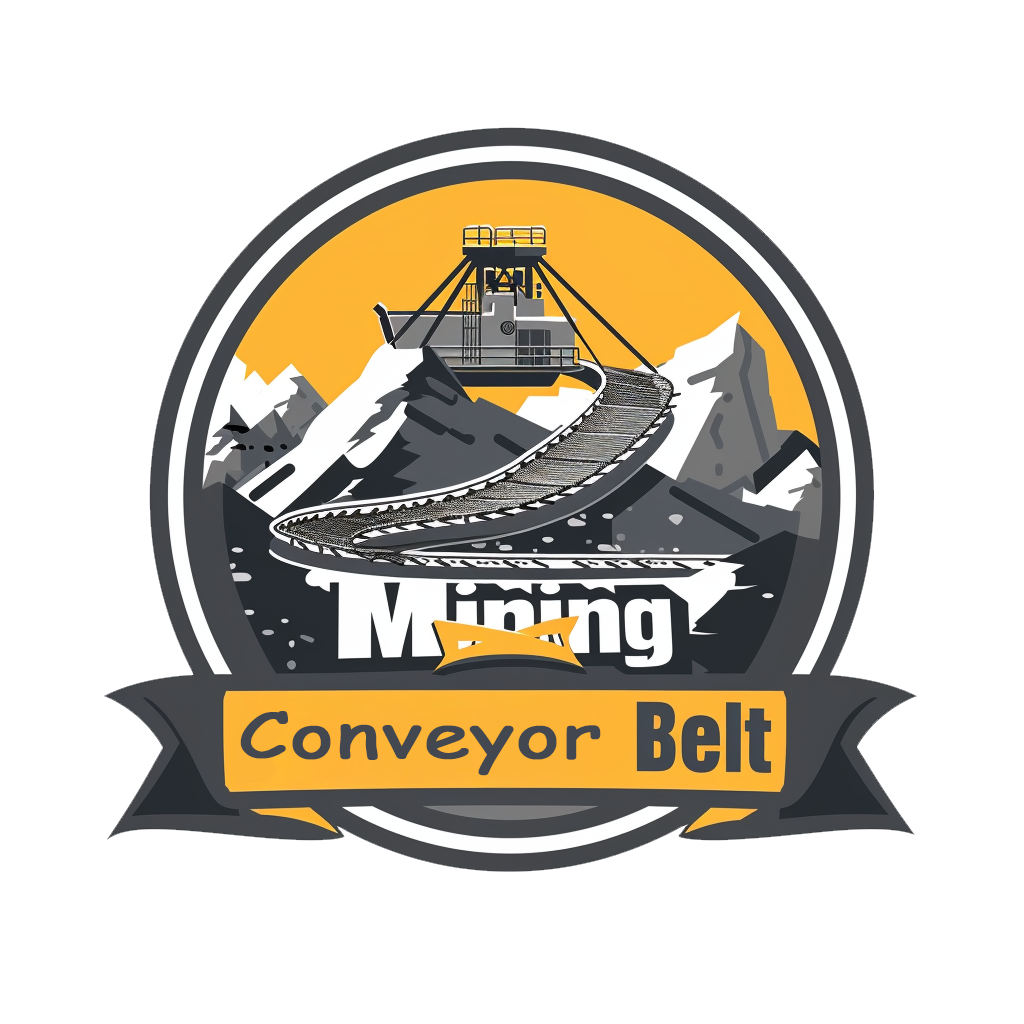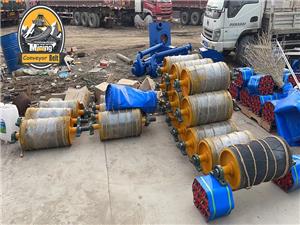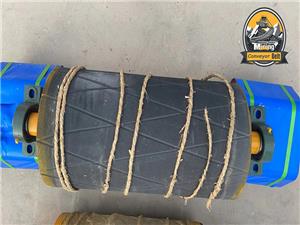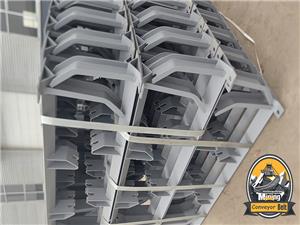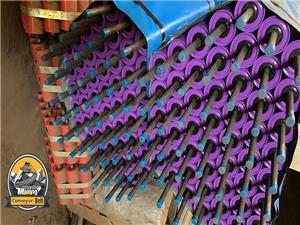Several common problems in the use of conveyor belts
1. The strength of the joint of the conveyor belt is lower than that of the normal belt body. When the mechanical form is generally used for jointing, the joint strength can only reach 40-50% of the belt body strength. When the cold glue form is of good quality, the joint strength can reach 60-70%, and the hot glue joint strength can reach 80-90% (the joint method is correct and there is no quality defect). Because the strength of the joint is relatively low, if the glue joint method is wrong, the strength of the joint will be even lower, such as cutting and grinding to damage the next layer of cloth, excessive grinding, insufficient overlap length, insufficient number of steps, the rubber used in the glue joint has very poor performance or has lost its effectiveness due to self-sulfurization, excessive grinding of the wire rope, rust of the wire rope, etc., the strength of the joint will be greatly reduced, and when used, it is easy to show the phenomenon of joint fracture.
In addition, if the conveyor belt is not considered appropriate and the sealing glue is used, or the direction of the glue joint is incorrect, the joint is prone to cracks (surface glue part).
2. What is the reason for the conveyor belt to slip?
When the conveyor belt is running normally, the belt speed is not less than 95% of the roller speed. If the friction between the roller and the conveyor belt is not enough, the conveyor belt will easily slip. There are many reasons for the insufficient friction between the driving roller and the conveyor belt, the common ones are: insufficient tension, load start working, insufficient friction coefficient of the roller surface, etc. The reasons for insufficient tension are: insufficient tension stroke, insufficient amount of matching, too long conveyor belt, etc.;
The reasons for insufficient friction coefficient of the roller surface are: the food glue made of roller surface powder and water fermentation is too abrasive, the belt body is too wet or sticky with lubricating oil, and the belt body surface is sticky with materials (easy to be swollen by water).
3. What are the requirements for the storage of adhesives and glue for bonding? Films and glues should be kept in a dark and dry place, avoid direct sunlight, avoid various radiation, and stay away from fire sources. Films and glues should be kept in dusty places to avoid contact with various chemicals. Keep the background moisture of the film and glue at 50%-75%, and the temperature should not be lower than 5℃ and not higher than 35℃. The shelf life of the film and glue: 1 month in summer, 2 months in winter, and 1.5 months in spring and autumn.
4. How to glue the belt?
Our company recommends that the conveyor belt be glued in the form of hot glue. The middle waist needs to be glued with core glue. Each step can only have one layer of cloth, and the joint direction should be along the direction of the conveyor belt.
5. The middle waist of the steel belt is torn 14-15 meters longitudinally. How to repair it? The upper and lower covering glue of the damaged part can be completely peeled off (the length exceeds the damaged part by 50-100mm, and the width exceeds the damaged part by 30-50mm), and at the same time, take a section of rubber with the same volume as the detached part (preferably with a layer of cloth), and then repair it according to the cold glue method.
6. Hot glue stripping method (can one end of the edge glue be removed)?
This is another bonding method, which is also acceptable. However, if you think it is appropriate to use this method, you should pay attention to the following points:
a. You must use sealing glue when you think it is appropriate;
b. The intersection of the edge glue parts must be connected by mature rubber;
c. The rubber connection parts must be polished.
If the treatment is not good, the edge glue parts are easy to be damaged.
7. Comparison between EP high temperature resistant belt and cotton canvas high temperature resistant belt:
a. Similarities: The surface covering glue is the same. b. Differences: Cotton canvas can withstand a maximum temperature of 150℃; EP-TNG canvas can be used for a long time at 200℃ and can be used at 220℃; Cotton canvas has a relatively low strength, only 50N/mm; EP-TNG canvas has a relatively high strength, and the commonly used 200 type is 200N/mm;
The adhesion of cotton canvas high temperature resistant tape is relatively low, and the adhesion of EP high temperature resistant tape is relatively high; The service life of EP high temperature resistant tape is generally longer than that of cotton canvas high temperature resistant tape.
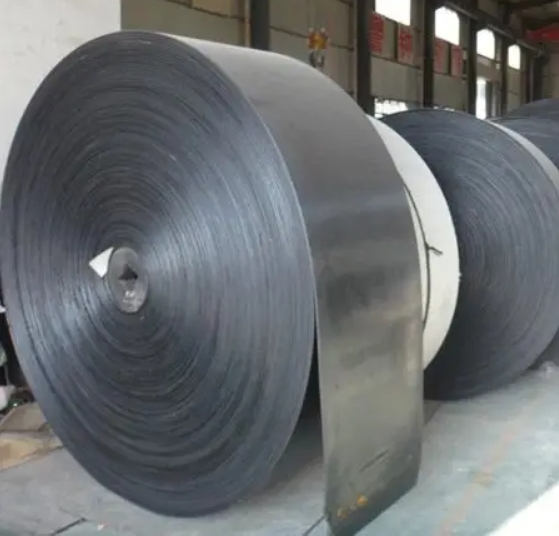
8. Can core glues from different manufacturers be mixed?
It is not recommended to mix core glues from different manufacturers, because the core glues from different manufacturers are prepared according to different prescriptions. There are many types of rubber additives, some of which will interact with each other. In the prescription of the same manufacturer, there will be additives with bad interactions, but the prescriptions of different manufacturers are very different. Using core rubbers from different manufacturers together may cause interactions between additives, affecting the application effect of core rubbers.
9. Is it good that the joint temperature reaches 120℃ but does not reach the normal vulcanization temperature?
No. The normal vulcanization cross-linking temperature of rubber is determined by the vulcanizer and promoter in the rubber. In order to ensure the safety of rubber processing, ordinary manufacturers will set the vulcanization start temperature of the rubber used in conveyor belts very low. Because of this, when the temperature reaches 120℃, the rubber will not enter the normal vulcanization state. Because of this, under the working condition of 120℃, the quality of the conveyor belt joint will be greatly affected.
Generally, when the vulcanization temperature is higher than the critical vulcanization temperature of the promoter and vulcanizer and does not reach the normal vulcanization temperature, the vulcanization time can be extended to make the vulcanization of the rubber meet the requirements. For every 10℃ drop in general temperature, the vulcanization time is extended by 2-4 times. Of course, due to performance considerations, we do not recommend the use of low-temperature and long-term vulcanization methods.
10. Why are the fabrics dense and coarse?
The density and coarseness of the fabrics are related to the type and strength of the fabrics. Because the modulus and strength of different fibers are different, in order to achieve the required strength, fibers and yarns of different diameters and deniers must be used, which reveals the differences in the density and coarseness of the fabrics. Generally speaking, polyester is denser than nylon and coarser than nylon; high-strength fabrics are denser and coarser than low-strength fabrics.
11. Why do other construction units generally not advocate the use of sealing glue?
The function of sealing glue is mainly to connect the two ends of the vulcanization, and at the same time prevent the entry of harmful media such as water, and prevent the joints from being damaged by the cleaner. Because of this, in order to synchronize the service life of the vulcanized joint with the belt body, and to extend the service life of the belt body, it is necessary to use sealing glue.
Using sealing glue to make vulcanized joints will increase the cost, and also increase the difficulty of glue joints. Because of this, some construction units will not advocate the use of sealing glue. In fact, doing so will have a negative impact on the service life of the conveyor belt.
12. Can I not put the core glue, but apply more layers of glue?
Glue is a colloid with a certain viscosity formed by dissolving the core glue in the solvent. After all the solvents evaporate, its composition is the same as the core glue. However, the commonly used glue is made by mixing the core glue and the solvent (such as toluene, xylene, solvent fuel, etc.) in a ratio of 1:5-1:6. The core glue is a soft film calendered by a calender. Its molecular arrangement is oriented in order. From a mechanical point of view, it has anisotropy, so the tensile properties and fatigue resistance along the calendering direction are better. The arrangement of rubber molecules in the solvent is random and isotropic. The function of the glue is to make the rubber dissolved in the solvent fully enter the fabric through the satisfactory fluidity and permeability of the solvent, so that the rubber can be better bonded to the fabric. Because the function of this core glue is to bond the fabric layers of the conveyor belt together, while eliminating the differences in stress and deformation between the layers of the conveyor belt caused by different thicknesses, and learning from the energy of local damage, because this core glue is a necessary part of the conveyor belt, some overseas manufacturers often consider it appropriate to use the method of thickening the thickness of the core glue in order to extend the service life.
If you only consider it appropriate to use the brush glue without the core glue, the thickness of the glue between the fabric layers at the joint will be relatively thin, and its application effect will also be affected.
13. When pulling the head, I found that the glue was attached to one layer of cloth, while the other layer of cloth was smooth. Why? (Is it best if there is the same amount of adhesive on both sides of the fabric?)
There are several reasons why the adhesive is attached to one layer of fabric:
a. The adhesion is very poor
b. The adhesion is relatively good, but the strength of the adhesive is higher
In general, when nylon belts and some EP belts are pulled, it is easy to show that there is adhesive on both sides, and the thickness of the adhesive is almost the same, while cotton canvas belts are easy to show the above-mentioned situation that there is adhesive on one layer of fabric and the other layer of fabric is light. Of course, EP belts with very poor adhesion or EP belts with good adhesion but higher adhesive strength will also show this situation.
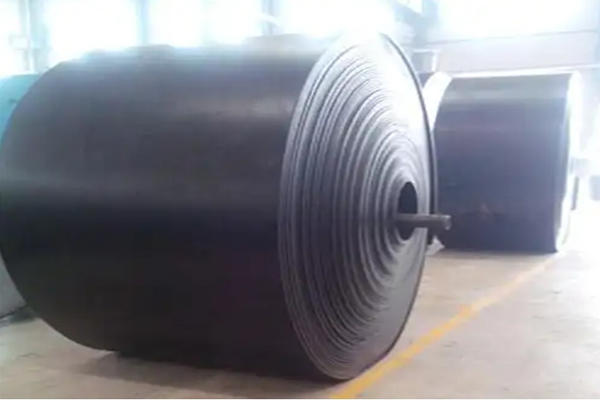
14. Why do you feel that the joints are harder than other parts? The process of vulcanization and bonding of conveyor belts is actually the process of cross-linking of mature rubber. Because vulcanization requires heating and increasing pressure, and it takes a long time, after a long period of vulcanization, the hardness of the mature rubber will increase, so it will feel that the joints are harder than other parts.
15. When the edge rubber is worn out during deviation and causes the fabric layer to delaminate, how to deal with it? In the case of half-size delaminated planes or surfaces, cold glue can be used for repair, but it is important to exhaust the air. Of course, the best way is to correct it when the conveyor belt is found to be deviating.
16. Can the wear of the roller cover be treated with cold glue or hot glue? The roller cover can be treated with cold glue on site after the wear, but the effect of on-site treatment is very poor. The roller cover that has been heat-treated can generally be used for more than 5 years, and the roller cover will not be peeled off due to unexpected events.
17. How to connect two conveyor belts with the same number of layers?
This method cannot be used in normal situations. However, when some unexpected events occur, this method can only be used when emergency situations are needed on site. When this method is considered appropriate and used, it is best to put a seam of one layer to two layers at the bottom, and put enough glue at the sealing glue to eliminate the influence of different thicknesses at both ends on the conveyor belt joint.
18. What are the advantages and disadvantages of EP belt and NN belt? NN conveyor belt is a substitute of cotton canvas conveyor belt. It has the advantages of high strength and good fatigue resistance. However, the elongation of NN conveyor belt is relatively large and easy to stretch during use. EP belt is an upgraded product of NN belt. It has the advantages of nylon conveyor belt. At the same time, because the elongation during use is relatively small, it has a wider range of applications. However, the bonding performance of EP canvas and rubber is not as good as NN canvas. Therefore, the safety of this bonding is not as good as that of NN conveyor belt.
19. Is it easy for a long conveyor belt to deviate? During the operation of the conveyor belt, it will sometimes show the phenomenon of deviation. Under normal circumstances, it is not common for the conveyor belt to deviate due to problems with the conveyor belt itself. The deviation of the conveyor belt is mainly caused by the conveyor. The conveyor belt can deviate due to uneven rollers, non-vertical brackets, and inflexible roller rotation. For a shorter conveyor belt, due to the high probability of one-side rollers not rotating flexibly and other factors, the conveyor belt is more likely to deviate. For a long conveyor belt, due to the increase in the number of rollers, the symmetry of the one-side effect will be reduced, so the deviation phenomenon on the conveyor belt will be reduced.
Of course, individual conditions are not taken into account, such as: the self-aligning roller is not flexible to shake back and forth or is tilted and fixed, the roller surface is not clean enough, etc., which can cause the conveyor belt to deviate.
20. What causes the conveyor belt to deviate on the bottom while the top does not deviate? The upper and lower sides of the conveyor belt affect each other and are independent of each other. Under normal circumstances, insufficient parallelism of the lower roller and the levelness of the roller will cause the conveyor belt to deviate on the bottom. The lower side is deviated, while the upper side is normal. This kind of working condition is basically caused by the poor thorough cleaning device, the material sticking to the lower roller, the uneven movement of the counterweight roller, or the tilted counterweight bracket, and the uneven movement of the lower rollers. The specific working condition should be adjusted according to the actual working condition. Generally speaking, the deviation of the lower side can be corrected. It can be corrected by improving the working state of the thorough cleaning device, cleaning the rollers and materials sticking to the rollers, adjusting the lower flat rollers, the lower V-shaped rollers, or installing the lower self-aligning rollers.
21. Why is it easy to deviate on rainy days? On rainy days, the outdoor conveyor belt is easy to get wet, and the rollers and rollers of the conveyor are also easy to get wet. The wet friction coefficient of rubber and metal is relatively small. If the rollers are not flexible or the surface of the rollers is sticky, the force on the rollers of the conveyor belt will be uneven, or the resistance on the rollers on both sides will be different. At this time, the conveyor belt will lose balance and deviate. In addition, when the surface of the roller is adhered to water-soluble materials, the thickness of the water film between the roller and the conveyor belt will increase, which is easy to cause slippage and make the conveyor belt deviate.
22. How to deal with the longitudinal joint found at the joint? The longitudinal joint of the conveyor belt is mainly found on wider or narrower conveyor belts. When gluing the joint, it is easy to find the overlapping of the longitudinal joint. Different gluing processes are affected differently by the longitudinal joint. If the conveyor belt is suitable and the process used is not overlapped, then the longitudinal joint will basically not have a negative impact on the joint. If it is overlapped, then the overlap will show the problem of large thickness in the overlap.When cutting, pay attention to distinguishing each layer clearly. All the layers that should be peeled off in a single layer should be peeled off, and nothing should be left. If it should not be peeled off, it should not be done unconsciously.
23. If cracks appear at the joint after vulcanization, can they be repaired with cold glue?
Yes. After the cracks appear at the joint after vulcanization, when handling, the conveyor belt to be handled should be thoroughly cleaned and the gas at the cracked part should be fully exhausted. If there is no way to exhaust the gas, you can cut a hole on the belt body and repair the cut hole after repairing. You can also dig the cracks and stick them with adhesives, or repair the cracks with hot repairs.
24. How to determine the length of the joint? The length of the joint is generally determined according to the type and number of layers of the conveyor belt fan material and the effective width of the vulcanizer. While satisfying the effective width of the vulcanizer, the length of the joint should be as large as possible and meet the requirements in question 4. In the case that the length of one vulcanizer is not satisfactory, two vulcanizers can be used for vulcanization together, and the intersection of the two vulcanizers can be treated with relevant materials to ensure a smooth transition between the two vulcanizers.
25. How to distinguish between NN and EP? The difference between NN and EP conveyor belts in appearance is: For NN conveyor belts and EP conveyor belts of the same strength level, NN conveyor belts are relatively thinner, and the yarn strands are relatively tighter when viewed from the cross section, while the yarn of EP conveyor belts is more curved when viewed from the side, and the distance between the two wave peaks is relatively large. In addition, the belt body of NN conveyor belts is relatively softer, while that of EP conveyor belts is relatively harder.
